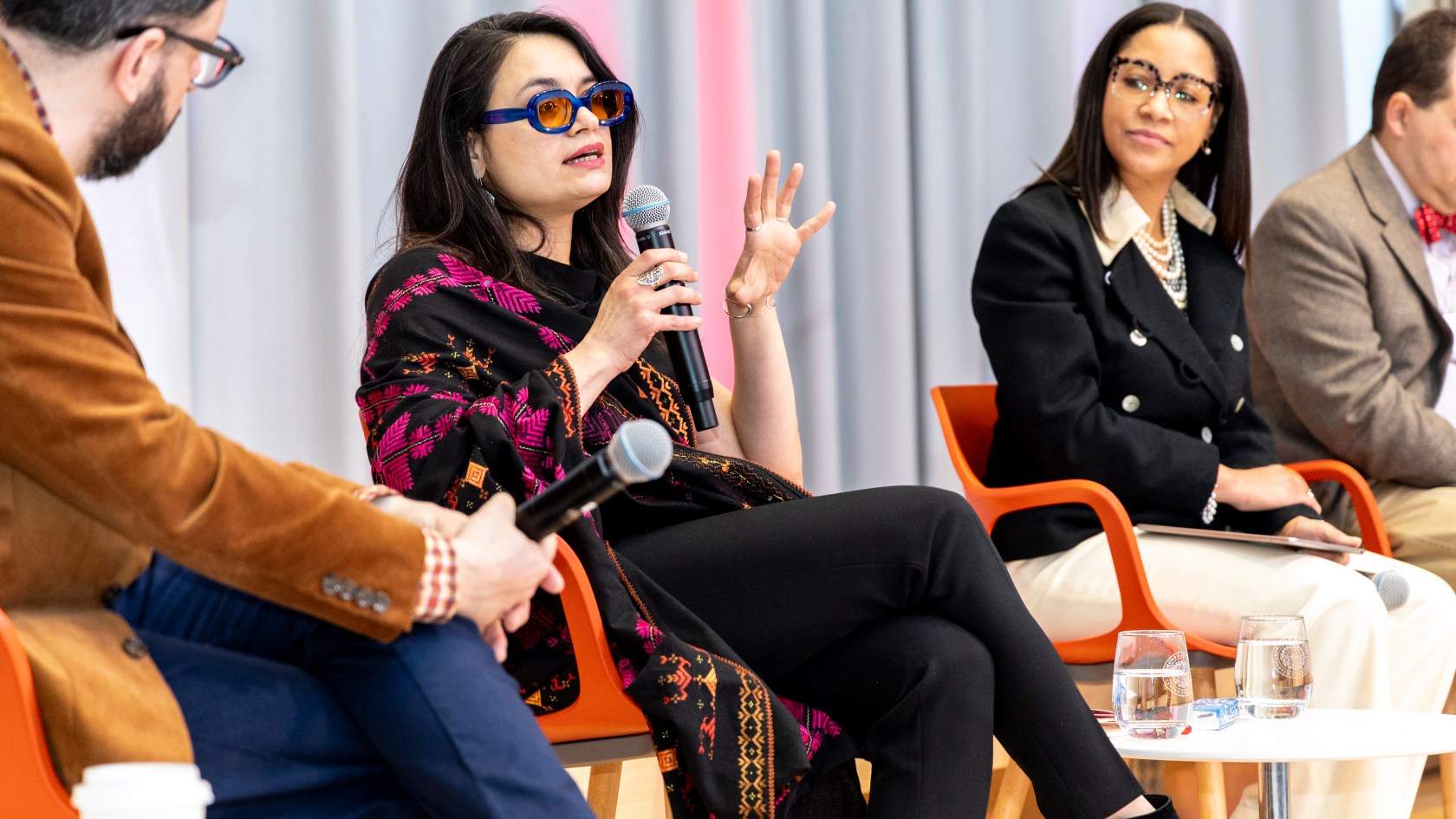
Amna Khalid, Associate Professor in the Department of History at Carleton College, speaks about the definition of DEI during the “Academic Freedom, DEI, & the Future of Higher Education” Panel at Harvard Commons in the Smith Campus Center at Harvard University. Photo by Dylan Goodman
Photo by Dylan Goodman
Pushing back on DEI ‘orthodoxy’
Panelists support diversity efforts but worry that current model is too narrow, denying institutions the benefit of other voices, ideas
It’s time to take a harder look at the role of Diversity, Equity, and Inclusion in higher education.
That was the overall theme of a searing panel discussion at Smith Campus Center on Thursday. Titled “Academic Freedom, DEI, & the Future of Higher Education,” the event featured scholars specializing in law, history, politics, and diversity.
“The power of diversity for learning is irreplaceable,” said panelist Amna Khalid, associate professor of history at Carleton College in Minnesota. “It is incredible, and it is a value that I strongly believe in as someone who is the product of various educational systems.”
However, Khalid shared that she often finds herself at odds with the approach DEI practitioners take in higher education — an approach she termed “DEI Inc.”
Khalid wrote an opinion piece with Carlton colleague Jeffrey Aaron Snyder last year for the Chronicle of Higher Education. The essay, titled “Yes, DEI Can Erode Academic Freedom. Let’s Not Pretend Otherwise,” argues that under the logic of the prevailing DEI model, “Education is a product, students are consumers, and campus diversity is a customer-service issue that needs to be administered from the top down.”
All too often, Khalid said at the event, practitioners implement a “model underscored by a notion of harm and that students somehow need to be protected from harm.”
Jeannie Suk Gersen, John H. Watson, Jr. Professor of Law at Harvard Law School, agreed with that assessment and said that people who object to DEI do not often equate it to the idea of diversity.
“It’s, in fact, a set of ideas that have become very narrowed to one specific orthodoxy about what diversity means, what equity and inclusion mean, so that it shuts out a whole bunch of other ideas about what diversity, equity, and inclusion may be,” Suk Gersen said.
The lone voice to advocate for a professionalized and accountable DEI workforce was Stacy Hawkins, a Rutgers University law professor and scholar of DEI.
“Perhaps it’s simply just the introduction of diversity into our institutions that’s going to create discomfort — that’s going to make it harder to have the same conversations, to do the same things, to say and behave in the same ways that we used to,” said Hawkins, who underscored the challenge of welcoming diverse students without diverse faculty. “But that doesn’t mean that it’s not a worthwhile exercise to try.”
Panelists also fielded questions on academic freedom and free speech, and whether DEI infringes on those rights.
DEI is “almost always wrong in the sense that it subverts classical liberal principles of the academic mission of open inquiry, truth seeking, knowledge creation, research, and debating ideas,” responded panelist Ilya Shapiro, senior fellow and director of constitutional studies at the Manhattan Institute.
He went on to quote Hanna Holborn Gray, former president of the University of Chicago, who once said: “Education should not be intended to make people comfortable; it is meant to make them think.”
Shapiro proved the only panelist to argue for the total elimination of university DEI offices without replacing them with other structures designed to achieve diversity goals. Instead, he said that student affairs, compliance officers, and admissions should assume any responsibilities related to diversity.
Last week’s discussion was sponsored by the Faculty of Arts and Sciences’ Civil Discourse Initiative, the Harvard College Intellectual Vitality Initiative, and the Edmond & Lily Safra Center for Ethics.
Also discussed were social media and the distorted views it surfaces on DEI.
Hawkins noted that DEI takes a real beating on the platforms, all while cancel culture is the true driver behind most modern outrage. “There is this heightened sense of awareness,” she said. “There’s this heightened sense of accountability. There is this heightened sense of threat. And this heightened sense of punitive action, all surrounding a larger cultural phenomenon that has nothing to do with diversity, equity, and inclusion.”




